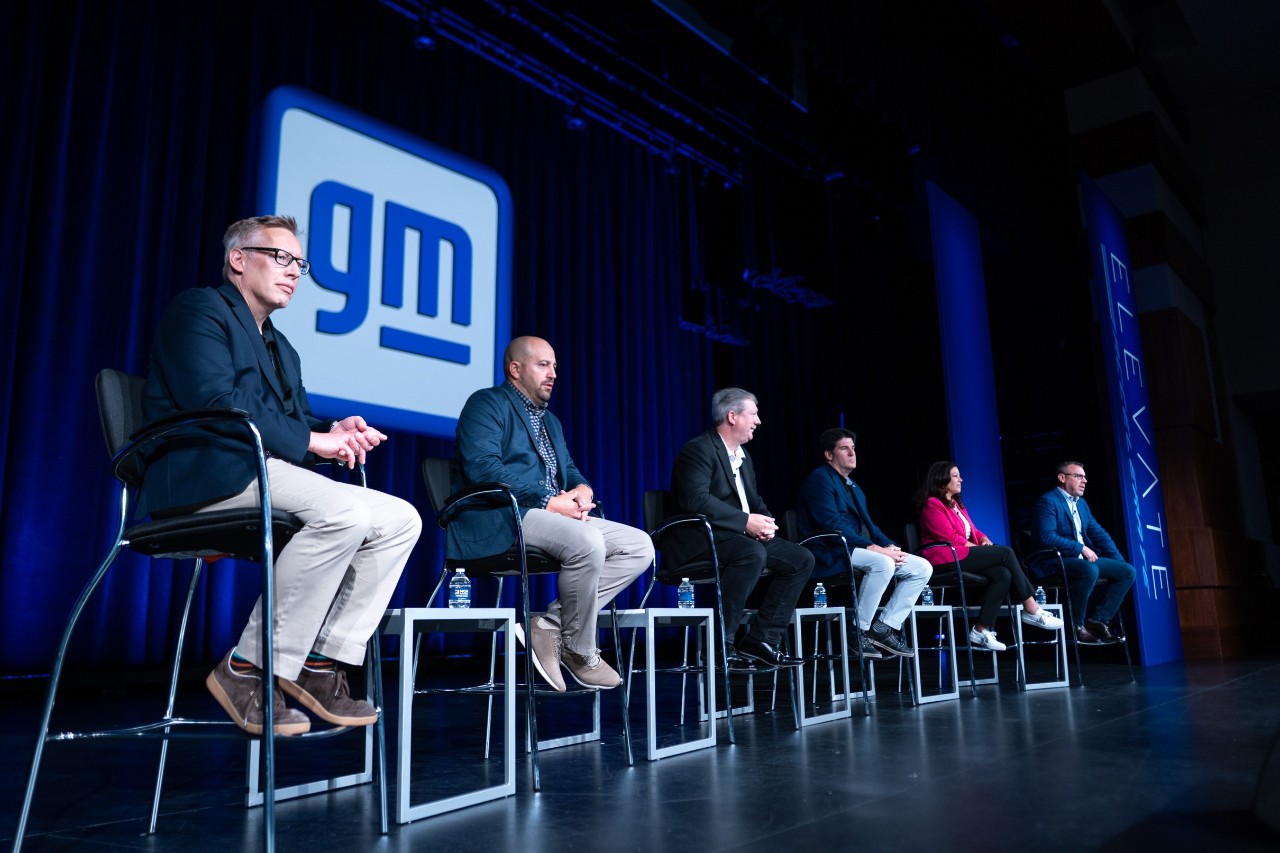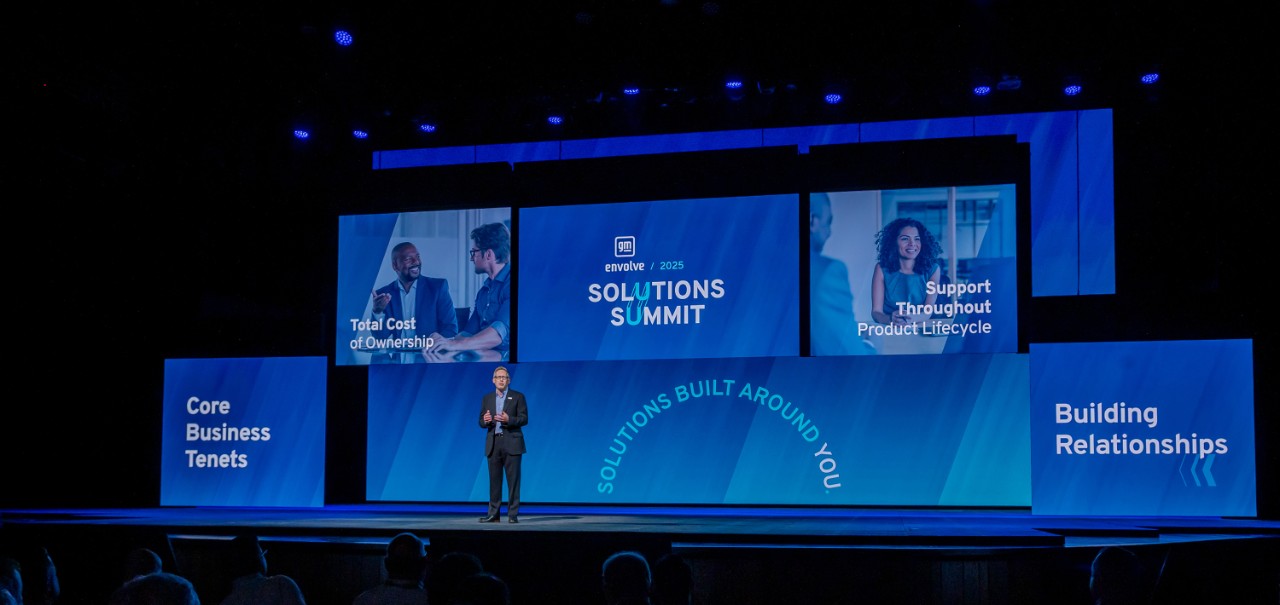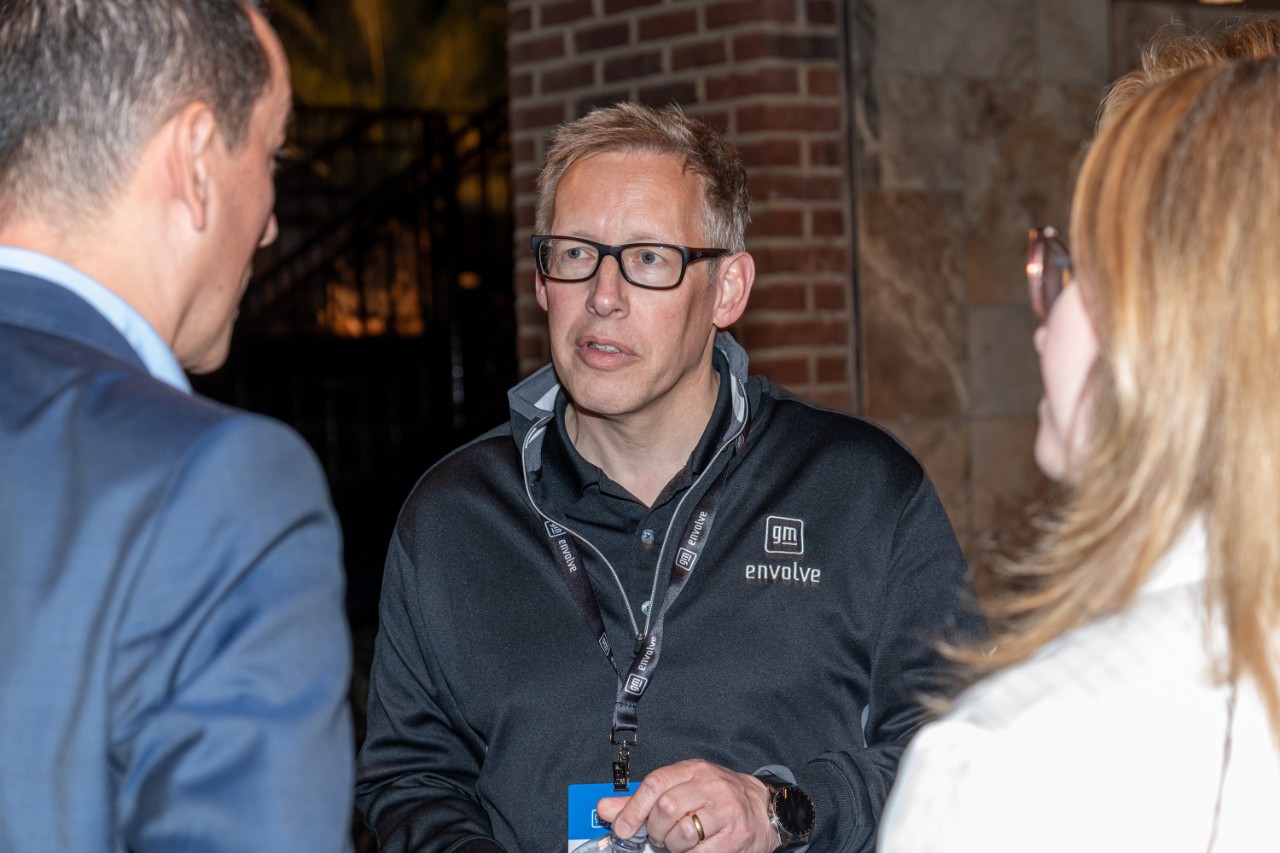By Eric J. Savitz, editor-in-chief, GM News
By Eric J. Savitz, editor-in-chief, GM News
Ian Hucker’s three-decade career in the auto business has taken him around the globe, to postings in Germany, Switzerland, Austria, Russia, and his home turf in the U.K. Other than an 18-month role in the late 1990s, one place he’s not lived for a while is Detroit. But that changed in April, when Hucker rejoined General Motors after a 7-year gap to run GM Envolve, the company’s fleet and commercial business, which accounts for about 20% of GM’s sales.
In a Q&A with GM News, Hucker provided insights on GM Envolve, the fleet business, and his long and winding journey to his new home base in Michigan.
Ian, welcome back to General Motors.
Thanks, it is great to be back. I was part of GM Europe for 25 years, right up until the point in 2017 where we divested the European operations, including Opel/Vauxhall, to Groupe PSA, which was a predecessor to Stellantis.
And while you are new to the U.S., you have deep experience in the fleet business.
My penultimate job at GM was running the European fleet team, covering all the markets from Portugal to Russia. I worked with the U.S. a lot – we had quite a few global accounts. We had shared customers and projects. I came to Michigan at least once a year, and some of the same people are still here. It’s made for a soft landing, and quick integration.
How do you feel about relocating to Detroit?
In the late ‘90s, I was working in product research, and I did an 18-month assignment at the Warren Tech Center, working for Buick. I swapped jobs with a U.S. colleague who went to Europe. They gave me Buick Park Avenue, to try to blow my mind as a European, this huge, long car. And they gave him the Opel Corsa, which was a little city car, to do exactly the same thing to him in reverse. I loved that time, and I nearly stayed, but they had something for me back in Europe. It was a “sliding doors” moment. It took a while, but it’s great to be back.
What have you been up to since we sold Opel/Vauxhall?
I stayed with what became Stellantis for two years, doing some integration work. After that, I took a time out and did my MBA. Shortly after that I had an opportunity to join Lynk & Co., which was kind of a startup owned by China’s Geely Group. Their angle was an all-subscription play across seven markets - 500 Euros down, 500 Euros a month for a midsize SUV.
Caption: Ian Hucker (left) on stage at TKTK with GM leaders Arnaldo Magnotta, VP of OnStar Services; TKTK of TKTK; Cadillac's John Roth; Buick and GMC's Jaclyn McQuaid; and Chevrolet's Scott Bell.
Like a lease, but open ended.
I learned about the subscription model, which was very much the zeitgeist in Europe at the time. When Geely changed direction, I joined Hyundai Capital Europe as chief commercial officer, going into financial services. I would still be there, but the chance to return to GM, and to fleet, with a bigger scale, at the mothership in the U.S … was just too big an opportunity to turn down.
Ian, explain what GM Envolve does.
We represent about 20% of GM’s sales, more than 25% if we include small business. It’s the fleet and commercial business with a customer base that spans sectors vital to the economy, including commercial enterprises, government, law enforcement, rental fleets, delivery and logistics, and utilities. Put simply, we sell vehicles to three main groups. There are commercial customers – household name companies. There’s government, which includes state and local, police forces, anything that operates in the public sector. And then there’s the rental vehicle business, which is an important component.
We adopted the Envolve name for the fleet business in 2023. What did that signify?
The name change recognized that we go beyond the vehicle itself, offering fleet customers additional products and services, to be more of a one-stop shop, with a consultancy approach to customers to really fulfill a wide range of their business needs.
Caption: Ian Hucker at the GM Envolve 2025 Solutions Summit in Nashville, Tennessee, in May 2025.
What do we supply beyond vehicles?
One of the major components is OnStar, which fleet managers leverage to maximize productivity by prioritizing safety, security, and optimal vehicle health. OnStar-and its safety ecosystem-is shaped by GM's 30 years of expertise. We’ve had huge growth in OnStar fleet customers, with paid subscriptions up 47% from a year ago. One thing that’s become really important is including cameras in the vehicles. We offer the OnStar DualCam in-vehicle camera system, with both a traditional dash cam that records what is happening in front of the vehicle, and a second camera facing inside the car to help to detect drowsy drivers and other issues. It really matters for insurance cases.
Fraud is a growing issue.
Something we've seen increasingly, is somebody will target a fleet vehicle, because they see the deep pockets of a major corporation and file an insurance claim. Having dash cam technology means you curtail that. That’s why the adoption rates are going up. It’s also a tool targeted at improving driver behavior.
You continue to add new features.
This year we added Drive Block, the ability to shut a vehicle down remotely. If a vehicle is someplace it shouldn’t be, you can disable it. Or if you are managing a depot, you can just lock down all the vehicles at night, to make sure they don’t go anywhere, and then reactivate them in the morning.
You provide tools to help improve the performance of both vehicles and their drivers.
Absolutely, that’s the core of it, telematics. Everything from efficient route planning to monitoring driver behavior. Fleet operators are looking at optimization, efficiency and to maximize up time. The vehicles are great, but fleet customers want to utilize them to the fullest in a business environment. These tools really help them do that. We can also remotely monitor vehicle conditions – low tire pressure, for instance, impacts fuel economy and creates a safety concern. We track oil life, to make sure maintenance is on pace to avoid issues down the road. In short, we can help keep the fleet healthy. OnStar, by the way, celebrates its 30th anniversary next year.
How do we differentiate ourselves against the competition?
There are three pillars that really matter to a fleet operator. The first is the vehicle itself. If the product is not right, it's really hard, but the vehicles we have in the portfolio are just fantastic. Whatever category we're in, we're offer products to meet the fleet customer’s requirements. There are some wide-ranging proof points. One equipment leasing company is running Silverados in the Alaskan tundra; a large oil company is using the same trucks in the New Mexico desert. It starts with the ability to do the job. On top of that, you have services. We discussed OnStar, but we also do other things, like consulting for fleets considering a transition to EVs. And we have a network of dedicated specialist dealers that have the facilities and personnel to handle fleet customers.
Are those dealers who also sell retail?
Yes. But they tend to have dedicated facilities for fleet, separate from the retail showroom. Particularly the largest ones. They aren’t just managing the flow of vehicles; they also provide upfit options for those who need customization, all the extra services to take a standard vehicle into something very specific for an operator’s needs. It boils down to vehicles; services, including our dealer networks; and also, our people.
Caption: Ian Hucker at the GM Envolve 2025 Solutions Summit.
The team matters.
We have a dedicated, experienced team that works closely with our fleet partners, to provide 360-degree service, and really understand their business. We're approachable, we're collaborative, we're solution-oriented, and we're there for them, whenever they need us. And we provide 1-to-1 dedicated support, so customers have a consistent point of contact. This is not just selling a vehicle. It is understanding their business and how it operates, understanding what matters and is important, understanding where they can achieve efficiency or savings. There’s a reason almost 70% of our fleet customers over the last 14 years are repeat customers – and nearly half have been customers for more than five years.
What vehicles dominate our fleet sales?
We've got our commercial products, the work trucks, Silverado, Colorado, etc. They're the foundation of our commercial business, alongside our long-lived GMC Savana and Chevrolet Express cargo vans. Our crossovers and full-size utility vehicles are extremely popular, certainly with government customers. The Tahoe PPV, or police patrol vehicle, does exceptionally well. The Equinox is very popular for fleets. Equinox EV also performs exceptionally well, as does the Silverado EV.
How much progress are we making with EVs selling to fleet customers?
Adoption is a little lower than the overall automotive industry. There are a couple of fundamental use cases. One is, a company has decided to adopt EVs, maybe to help meet their own global emissions targets. And another is where there are specific use cases for which EVs offer the most cost-effective solution. We have a number of long-term partners who can help customers with conversions, or "upfitting" of vehicles to specific uses.
Coming back to where we started, Ian, you have this long and diverse background, having worked in many countries. How has that experience affected your approach to the job?
In the fleet business, the fundamentals are basically the same everywhere. It's a commercial decision to acquire vehicles to fulfill a specific role and job within the organization. Ultimately, it's about finding the right product, the right vehicle for the application, but also making sure the total cost of ownership, the whole life cost of that vehicle is competitive and within the customer’s financial constraints. Generally speaking, fleet is fleet, and that's what's been so fun about doing the different relative regions. The basics are always there.
Ian, thanks so much!
Eric J. Savitz, a former reporter and columnist with Barron’s, Forbes, and other publications, is editor-in-chief at GM News. Reach him at news@gm.com.

Ian Hucker’s three-decade career in the auto business has taken him around the globe, to postings in Germany, Switzerland, Austria, Russia, and his home turf in the U.K. Other than an 18-month role in the late 1990s, one place he’s not lived for a while is Detroit. But that changed in April, when Hucker rejoined General Motors after a 7-year gap to run GM Envolve, the company’s fleet and commercial business, which accounts for about 20% of GM’s sales.
In a Q&A with GM News, Hucker provided insights on GM Envolve, the fleet business, and his long and winding journey to his new home base in Michigan.
Ian, welcome back to General Motors.
Thanks, it is great to be back. I was part of GM Europe for 25 years, right up until the point in 2017 where we divested the European operations, including Opel/Vauxhall, to Groupe PSA, which was a predecessor to Stellantis.
And while you are new to the U.S., you have deep experience in the fleet business.
My penultimate job at GM was running the European fleet team, covering all the markets from Portugal to Russia. I worked with the U.S. a lot – we had quite a few global accounts. We had shared customers and projects. I came to Michigan at least once a year, and some of the same people are still here. It’s made for a soft landing, and quick integration.
How do you feel about relocating to Detroit?
In the late ‘90s, I was working in product research, and I did an 18-month assignment at the Warren Tech Center, working for Buick. I swapped jobs with a U.S. colleague who went to Europe. They gave me Buick Park Avenue, to try to blow my mind as a European, this huge, long car. And they gave him the Opel Corsa, which was a little city car, to do exactly the same thing to him in reverse. I loved that time, and I nearly stayed, but they had something for me back in Europe. It was a “sliding doors” moment. It took a while, but it’s great to be back.
What have you been up to since we sold Opel/Vauxhall?
I stayed with what became Stellantis for two years, doing some integration work. After that, I took a time out and did my MBA. Shortly after that I had an opportunity to join Lynk & Co., which was kind of a startup owned by China’s Geely Group. Their angle was an all-subscription play across seven markets - 500 Euros down, 500 Euros a month for a midsize SUV.

Like a lease, but open ended.
I learned about the subscription model, which was very much the zeitgeist in Europe at the time. When Geely changed direction, I joined Hyundai Capital Europe as chief commercial officer, going into financial services. I would still be there, but the chance to return to GM, and to fleet, with a bigger scale, at the mothership in the U.S … was just too big an opportunity to turn down.
Ian, explain what GM Envolve does.
We represent about 20% of GM’s sales, more than 25% if we include small business. It’s the fleet and commercial business with a customer base that spans sectors vital to the economy, including commercial enterprises, government, law enforcement, rental fleets, delivery and logistics, and utilities. Put simply, we sell vehicles to three main groups. There are commercial customers – household name companies. There’s government, which includes state and local, police forces, anything that operates in the public sector. And then there’s the rental vehicle business, which is an important component.
We adopted the Envolve name for the fleet business in 2023. What did that signify?
The name change recognized that we go beyond the vehicle itself, offering fleet customers additional products and services, to be more of a one-stop shop, with a consultancy approach to customers to really fulfill a wide range of their business needs.

What do we supply beyond vehicles?
One of the major components is OnStar, which fleet managers leverage to maximize productivity by prioritizing safety, security, and optimal vehicle health. OnStar-and its safety ecosystem-is shaped by GM's 30 years of expertise. We’ve had huge growth in OnStar fleet customers, with paid subscriptions up 47% from a year ago. One thing that’s become really important is including cameras in the vehicles. We offer the OnStar DualCam in-vehicle camera system, with both a traditional dash cam that records what is happening in front of the vehicle, and a second camera facing inside the car to help to detect drowsy drivers and other issues. It really matters for insurance cases.
Fraud is a growing issue.
Something we've seen increasingly, is somebody will target a fleet vehicle, because they see the deep pockets of a major corporation and file an insurance claim. Having dash cam technology means you curtail that. That’s why the adoption rates are going up. It’s also a tool targeted at improving driver behavior.
You continue to add new features.
This year we added Drive Block, the ability to shut a vehicle down remotely. If a vehicle is someplace it shouldn’t be, you can disable it. Or if you are managing a depot, you can just lock down all the vehicles at night, to make sure they don’t go anywhere, and then reactivate them in the morning.
You provide tools to help improve the performance of both vehicles and their drivers.
Absolutely, that’s the core of it, telematics. Everything from efficient route planning to monitoring driver behavior. Fleet operators are looking at optimization, efficiency and to maximize up time. The vehicles are great, but fleet customers want to utilize them to the fullest in a business environment. These tools really help them do that. We can also remotely monitor vehicle conditions – low tire pressure, for instance, impacts fuel economy and creates a safety concern. We track oil life, to make sure maintenance is on pace to avoid issues down the road. In short, we can help keep the fleet healthy. OnStar, by the way, celebrates its 30th anniversary next year.
How do we differentiate ourselves against the competition?
There are three pillars that really matter to a fleet operator. The first is the vehicle itself. If the product is not right, it's really hard, but the vehicles we have in the portfolio are just fantastic. Whatever category we're in, we're offer products to meet the fleet customer’s requirements. There are some wide-ranging proof points. One equipment leasing company is running Silverados in the Alaskan tundra; a large oil company is using the same trucks in the New Mexico desert. It starts with the ability to do the job. On top of that, you have services. We discussed OnStar, but we also do other things, like consulting for fleets considering a transition to EVs. And we have a network of dedicated specialist dealers that have the facilities and personnel to handle fleet customers.
Are those dealers who also sell retail?
Yes. But they tend to have dedicated facilities for fleet, separate from the retail showroom. Particularly the largest ones. They aren’t just managing the flow of vehicles; they also provide upfit options for those who need customization, all the extra services to take a standard vehicle into something very specific for an operator’s needs. It boils down to vehicles; services, including our dealer networks; and also, our people.

The team matters.
We have a dedicated, experienced team that works closely with our fleet partners, to provide 360-degree service, and really understand their business. We're approachable, we're collaborative, we're solution-oriented, and we're there for them, whenever they need us. And we provide 1-to-1 dedicated support, so customers have a consistent point of contact. This is not just selling a vehicle. It is understanding their business and how it operates, understanding what matters and is important, understanding where they can achieve efficiency or savings. There’s a reason almost 70% of our fleet customers over the last 14 years are repeat customers – and nearly half have been customers for more than five years.
What vehicles dominate our fleet sales?
We've got our commercial products, the work trucks, Silverado, Colorado, etc. They're the foundation of our commercial business, alongside our long-lived GMC Savana and Chevrolet Express cargo vans. Our crossovers and full-size utility vehicles are extremely popular, certainly with government customers. The Tahoe PPV, or police patrol vehicle, does exceptionally well. The Equinox is very popular for fleets. Equinox EV also performs exceptionally well, as does the Silverado EV.
How much progress are we making with EVs selling to fleet customers?
Adoption is a little lower than the overall automotive industry. There are a couple of fundamental use cases. One is, a company has decided to adopt EVs, maybe to help meet their own global emissions targets. And another is where there are specific use cases for which EVs offer the most cost-effective solution. We have a number of long-term partners who can help customers with conversions, or "upfitting" of vehicles to specific uses.
Coming back to where we started, Ian, you have this long and diverse background, having worked in many countries. How has that experience affected your approach to the job?
In the fleet business, the fundamentals are basically the same everywhere. It's a commercial decision to acquire vehicles to fulfill a specific role and job within the organization. Ultimately, it's about finding the right product, the right vehicle for the application, but also making sure the total cost of ownership, the whole life cost of that vehicle is competitive and within the customer’s financial constraints. Generally speaking, fleet is fleet, and that's what's been so fun about doing the different relative regions. The basics are always there.
Ian, thanks so much!
Eric J. Savitz, a former reporter and columnist with Barron’s, Forbes, and other publications, is editor-in-chief at GM News. Reach him at news@gm.com.